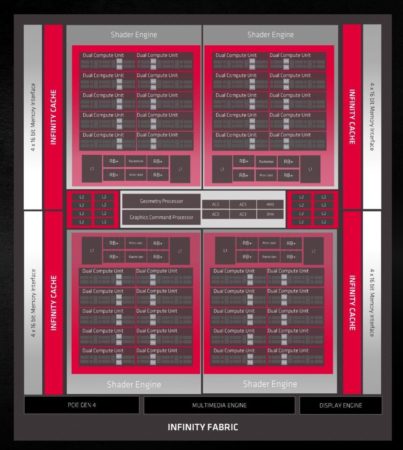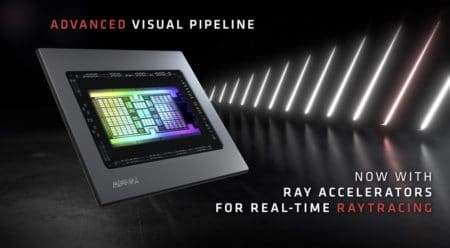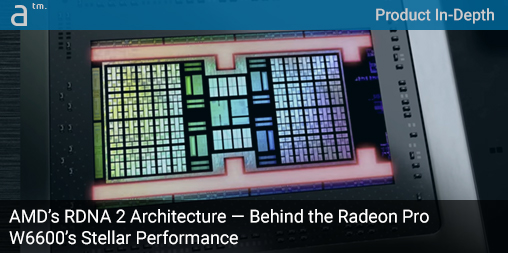WE RECENTLY REVIEWED THE AMD Radeon Pro W6600 GPU aimed at the professional engineering software markets, particularly segments connected to workflows with real-time raytracing workflows. One of those segments is the general architectural market, in tandem with the professional architectural visualization market.
The W6600 delivered some impressive stats in our benchmarks and real-usage apps tests. (see: Architosh, “Product Review: AMD Radeon Pro W6600 GPU for Workstations,” 1 Oct 2021) The new AMD Radeon Pro 6000 series GPUs offer hardware-accelerated raytracing engines, competitive to comparables by NVIDIA. They presently deliver arguably the best performance per dollar offering in the workstation GPU entry-mid-level market segment.
In the RDNA 2 Architecture
The AMD RDNA 2 architecture improves upon RNDA by up to 54 percent, with performance gains attributed to design frequency (clock) increases, power optimizations, and performance per clock enhancements driven by the new AMD Infinity Cache.
While the previous RDNA GPUs were also built on a TSMC-based 7nm node, improvements in chip manufacturing have improved that enhanced 7nm node helping to boost overall chip efficiency. For better power optimizations, RNDA 2 introduced pervasive fine-grain clock gating, aggressive pipeline rebalancing, and improved the routing for data paths to move data more efficiently—all lessons that came to RDNA 2 from their Zen era CPU chip development.

AMD’s RDNA 2 architecture for its GPUs is shown here in detail. Notice the “RA” in each Compute Unit. This is dedicated hardware for raytracing on DirectX Raytracing, Vulkan, and other real-time raytracing APIs. On the Cover image: The Infinity Cache provides quick access to massive data, speeding up overall GPU performance.
Overall, AMD tells Architosh that the combinations of power-saving techniques in RDNA 2 yielded 30 percent per cycle per compute unit and up to a 30 percent frequency boost at the same power level. 21 percent of the 54 percent improvement over RDNA GPU performance is attributed to performance per clock enhancements, largely due to Infinity Cache.
Infinity Cache
So what is Infinity Cache, you may ask? Infinity Cache is a large L3-level memory cache that sits alongside the computational units (CUs) along the far side of the GPU. It sits between the DRAM on the GPU die package and the GPU core with its compute cores (including embedded ray accelerators).
Infinity Cache technology offers up to 2.4x greater bandwidth per watt than just GDDR6 memory alone, as in the previous RDNA generation GPUs. This technology leverages what AMD learned from its Zen architecture for its CPUs. This architecture has propelled its latest Zen 3 CPUs ahead of rival Intel and currently holds industry-leading benchmark crowns in both single and multi-core CPU performance. The first instance of the Infinity Cache was used on an AMD EPYC CPU in the server space.
Infinity Cache is a powerful memory fabric technology that links directly to processing cores on chips and offers a massive pool of relatively fast-to-access data. This is so much better for the GPU than querying much slower GDDR6 memory.
Ray Accelerators
Another critical aspect of the RDNA 2 architecture is the emergence of hardware-based raytracing acceleration. By adding a fixed-function Ray Accelerator engine to each Compute Unit, AMD RDNA 2-based graphics cards optimize real-time lighting, shadow, and reflection realism with DirectX Raytracing (DXR).

A really big part of the excitement in RDNA 2 architecture from AMD is the new hardware-accelerated raytracing technology.
Additionally, when paired with AMD FidelityFX, a technology that enables hybrid rendering, developers can combine rasterized and raytraced effects to ensure an optimal combination of image quality and performance. By duplicating each Compute Unit and Ray Accelerator, they can efficiently work on parallel jobs from the software, such as displaying images on the screen.
In the RDNA-based generation of AMD GPUs, pro apps are rendered using the GPU with the execution of the raytracing happening in software (on the GPU). Now RDNA 2 brings dedicated hardware to the task of real-time raytracing. For readers of Architosh, this means that your pro apps, when they are tapping into DirectX Raytracing (DXR), AMD’s RadeonProRender, or Vulkan raytracing APIs, will fully utilize the Ray Accelerators.
A final note. This latest RNDA 2 architecture is specifically designed to accelerate raytracing calculations to boost offline rendering performance even further, plus real-time raytracing in real-time applications like Epic’s Twinmotion, which Architosh included in its review of the AMD Radeon Pro W6600.
Closing Comments
AMD’s RDNA 2 Architecture offers both professionals and gamers technology that goes toe-to-toe with its chief rival in NVIDIA. With AMD tapping into critical technologies from its Zen architecture for CPUs, the company offers specialized features like its Infinity Cache. That technology alone accounts for a sizeable performance speed up.
As we saw in our recent review, AMD’s latest set of professional RadeonPro GPUs with RDNA 2 Architecture provide industry-leading performance per dollar value. It’s exciting to think about where AMD is headed, given its fantastic progress in the CPU wars with Intel and how it is bringing its innovation to bear in the GPU arena.




Reader Comments
Comments for this story are closed